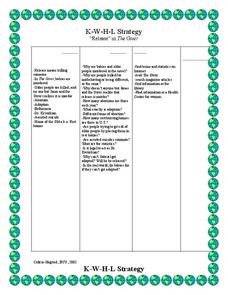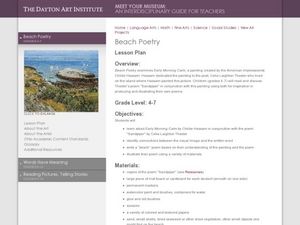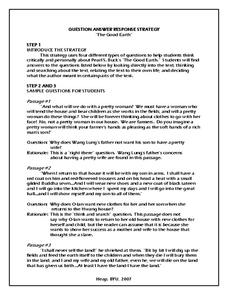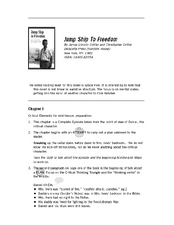Curated OER
Sentence Completion 11: High-Intermediate Level
Build vocabulary and critical thinking skills with a sentence completion instructional activity that comes with an answer and explanations key. The key unlocks for learners logic and comprehension strategies they can use to determine the...
Curated OER
Hatchet: Vocabulary Strategy
Want your class to use critical thinking when discussing vocabulary? Go beyond the dictionary with a vocabulary activity based on Gary Paulsen's Hatchet. Kids write the word in the center of a graphic organizer that also provides...
Curated OER
36 Public Policy Questions to Energize Your Government/History Classroom Debates
Need topics that are sure to engage your debaters? This list of public policy questions includes such topics as school mascots, regulation of major league baseball, physician-assisted suicide, and violence in video games. A great...
Novelinks
Touching Spirit Bear: Directed Reading Thinking Activity
What experiences lead people to change and how do they do it? After reading about Cole's encounter with Touching Spirit Bear, readers complete the second out of a series of five activities to predict future events in the text. The...
Curated OER
Measure for Measure: DRTA Strategy
“The tempter or the tempted, who sins most?” Prediction, verification, judgment, and extensions of thought are all part of a
Directed ReadingThinking Activity (DRTA) developed for Measure for Measure. The rationale, assessments...
Curated OER
Lesson: Paul Chan: "Score for the 7th Light"
Music, art, and poetry coalesce in a single exhibition, and in a single lesson. Critical thinkers analyze the Fluxus art movement as it's seen in the work of Paul Chan's 7 Lights. They consider the use of poetry and music in his...
Novelinks
Where the Red Fern Grows: Graphic Organizer, Story Map
How do you grow a goal from a dream to reality? You make a plan! After reading chapters two and three of Where the Red Fern Grows, learners map how Billy earns his dogs by completing an organizer in pairs and then discussing answers in...
Curated OER
The Giver: K-W-H-L Strategy
Explore the theme of release and death in Lois Lowry's The Giver with a K-W-H-L chart. After noting what they already know, kids come up with a list of questions about topics that they would like to know about, as well as how they...
Public Schools of North Carolina
Math Stars: A Problem-Solving Newsletter Grade 1
Keep the skills of your young mathematicians up-to-date with this series of newsletter worksheets. Offering a wide array of basic arithmetic, geometry, and problem solving exercises, this resource is a great way to develop the...
Curated OER
Reading Comprehension
After listening to a story learners engage in a kinesthetic activity to answer comprehension and critical thinking questions. Finally, the students identify three main facts about the story. Extensions include a fact and opinion...
Curated OER
Iraq's Latest Strategy: Suicide Attacks
This discussion based lesson focuses on the sensitive topic of suicide attacks or bombings used throughout history during times of militaristic upheaval. Learners read news stories, compose journal entries, and engage in a class...
Curated OER
Applying KWL Guides to Sources with Elementary Students
What is a KWL chart? Here is a well thought-out lesson that has learners use KWL charts to gain historical perspective. Your class examines primary sources about historical events and identifies what they know, want to know, and,...
Curated OER
Beach Poetry
Familiarize young analysts with the relationship between words, meaning, and visual images. They consider the relationship between the painting Beach Poetry and the poem Sandpaper. They compose and illustrate an original a...
Scholastic
Problem-Soving Strategies, Practice 1: Sample
A variety of word problems help your learners examine the ways that they find solutions. Each question provides opportunities to add, subtract, and multiply time, measurements, and money.
Minnesota Literacy Council
Introduction to Historical Thinking
Christopher Columbus: hero or villain? Prepare class members for the debate with activities that asks them to think critically about how history is reported.
Novelinks
The Good Earth: Question Answer Response Strategy
Readers of Pearl Buck's The Good Earth craft and answer "Right There," "Think and Search," "On Your Own," and "Author and You" questions.
Curated OER
Sentence Completion 12: Low-Advanced SAT Level
Desiccate, despoil, devise, descry! You would be remiss if you did not use this sentence completion worksheet to challenge even your best pundits. The SAT level words and the beautifully detailed explanations key would help to ameliorate...
Curated OER
The Old Man and the Sea: Vocabulary Strategy
Readers read more closely when they think critically about a text. Discuss the words and concepts from Ernest Hemingway's The Old Man and the Sea with a class activity that asks readers to not only record...
Curated OER
Maus: Cubing Questioning Strategy
Maus is the text for a postreading activity that has class members using a cubing strategy to analyze, in depth, topics (racism, past and present, forgetting/remembering the Holocaust, representing the Holocaust) associated with Art...
Curated OER
Colonialism in Africa
Students examine Africa from a regional perspective. They appreciate the historic and geographic relationships that unite and divide the regions of Africa. Students create a comprehensive document outlining problems in the assigned...
Curated OER
Jump Ship To Freedom: A Mindwing Lesson
Focusing on chapters 1-4 from the book, Jump Ship to Freedom, this helpful resource outlines critical thinking questions using evidence from the text to deepen overall reading comprehension. Note: Familiarity with mindwing concepts is...
Novelinks
The Tempest: QAR
Asking questions about a text is an effective way to improve reading comprehension. Apply the Question Answer Response strategy to your unit on William Shakespeare's The Tempest. As kids read each passage, they decide if the answer...
Newseum
Bias Through History: Analyzing Historical Sources
Young journalists use the E.S.C.A.P.E. (evidence, source, context, audience, purpose, and execution) strategy to evaluate historical and contemporary examples of bias in the news. The class then uses the provided discussion questions to...
Nebraska Department of Education
Stress and Coping
Life can be stressful. Class members fill out T-charts identifying stressors associated with school, parents, friends, and life then list coping strategies that can help with each category.

























